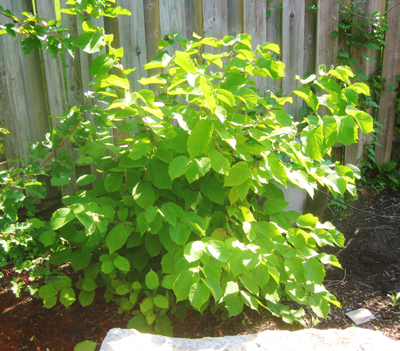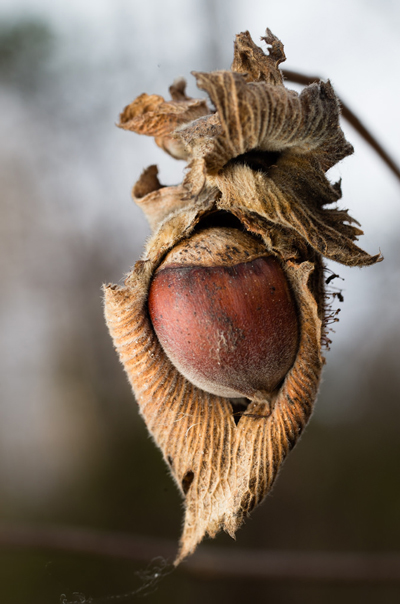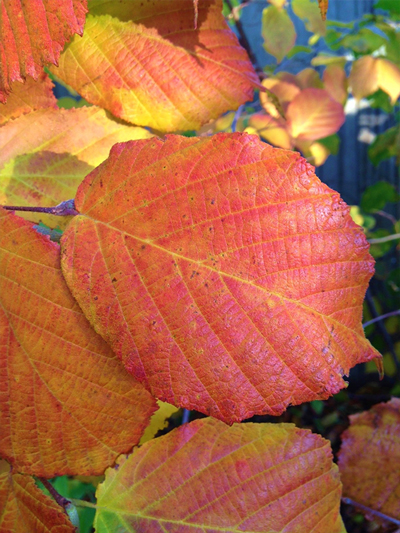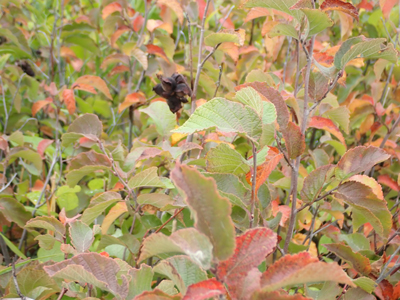As someone who has often enjoyed hazelnut-flavoured coffees and hazelnut chocolate products like Nutella and Ferrero Rocher throughout my life, I was surprised to discover that I could grow hazelnuts right here in Toronto from a native shrub. American hazelnut (Corylus americana) is a shrub species native to southern Ontario that produces edible nuts similar in taste to the hazelnuts of the European hazelnut (Corylus avellana) found on grocery store shelves. Unlike its non-native counterpart, American hazelnut does not require orchards or Mediterranean climates for production. Along with its edible nuts, American hazelnut shrubs offer seasonal beauty as well as food and habitat for a wide variety of native wildlife species.

Some of my favourite aspects of the American hazelnut shrub are its hardiness and adaptability. Able to thrive in full to partial sun conditions, this shrub grows in most soil types including tough, compact clay. It can also tolerate wet soil conditions. In the wild, American hazelnuts can be found in a variety of environments, from forest interiors, forest edges and meadow-like areas.
Historically, the American hazelnut was used as a food source, often being preserved through drying and being ground into flour or paste, and the bark, stems and roots were used medicinally or for tool construction. They were also roasted to snack on or for inclusion in baked dishes. Planting American hazelnuts in your own backyard would be an ode to the ecological heritage and botanical history of North America!

In terms of its physical traits, I think the three most striking features an American hazelnut shrub can bring to your yard are its size, fruit and fall colour.
Size
Reaching an average mature height of twelve feet and spread of eight feet in urban areas, the dense foliage and multi-stemmed form of the American hazelnut make it a great choice for hedges and natural privacy screens. These features also create habitat for many birds and small mammals.
Colour
American hazelnut shrubs offer evolving beauty throughout the year. In early spring, its golden catkins (flowers) are much appreciated by pollinating bees looking to get an early start. In the summer, its dark green leaves feed a various species of caterpillars and moth larvae then turn a kaleidoscopic of yellow, red and orange colours in the fall.

Nuts
When ripe, hazelnuts are a food source for many species of birds and mammals including our Canadian icon, the beaver. Humans can enjoy these nuts as well. American hazelnuts are a great source of essential fatty acids, fiber, iron and calcium and contain more protein than European hazelnut varieties. This makes them especially high in nutritional value compared to many other native nuts, such as acorns and beechnuts. To maximize hazelnut production in your yard, be sure to plant shrubs in multiples to increase your chances of a good yield!
The American hazelnut is a fantastic shrub for almost any home or garden! Its hardiness and adaptability are well suited for many conditions and make it an easy shrub to grow, even for novice gardeners. Its seasonally evolving colours and tall, dense form that provides privacy make it an attractive and functional addition to a yard. Its hazelnuts, flowers and dense foliage also provide food and habitat for a variety of wildlife helping to promote biodiversity in the urban forest.

If you are interested in adding one of these shrubs to your backyard this season, LEAF has you covered! Our American hazelnut shrubs can be purchased individually or as part of one of our discounted shrub bundles. Choose between the Privacy, Edible or the Create Your Own Bundles and receive four native shrubs delivered right to your door for only $100+HST! Every order includes mulch and a Planting and Care Guide and themed bundles include a specialized fact sheet. Visit our Shrubs, Cedars and Pawpaws page to learn more and get started on your order today with our Shrub Request Form.
Joel S. is the Residential Planting Programs Field Assistant at LEAF.
LEAF offers a subsidized Backyard Tree Planting Program for private property. The program is supported by the City of Toronto, the Regional Municipality of York, the City of Markham, the Town of Newmarket, the City of Vaughan, the Regional Municipality of Durham, the Town of Ajax, the Municipality of Clarington, the City of Oshawa, the City of Pickering, the Township of Scugog and the Town of Whitby.
